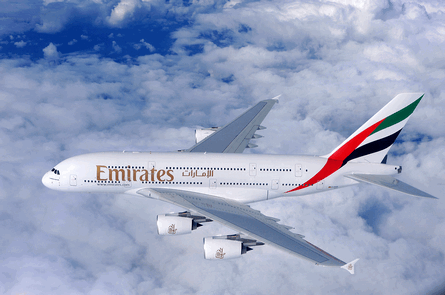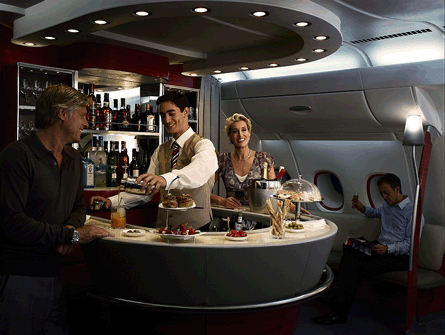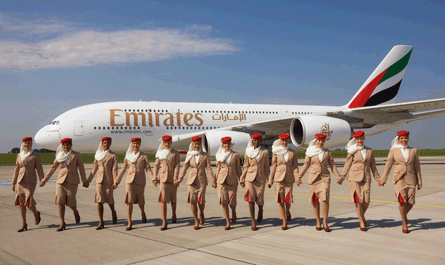Emirates' enormous appetite for pilots and other professionals may not be what it was in early 2008, but the region's biggest airline - with 131 aircraft and 163 on order - expects to be taking on flightcrew again soon as its fleet still expands during the downturn.
"This time a year ago, we were worried we could not find pilots," says senior vice-president human resources Sophia Panayiotou. "Now our recruitment has slowed down and almost stopped, However, as we get into our new financial year [to 31 March 2010], we will be recruiting."
 |
|---|
© Emirates |
Delays to deliveries of Airbus A380s and Boeing 777-300s in the last financial year, coupled with the effect of the downturn on cargo and passenger traffic, have left Emirates with more pilots than it needs, despite the fact that the total number of recruits - 340 - was down on the 450 it had expected to need.
"We took on every single person in 2008-9 that we gave concrete offers to," says Capt Alan Stealey, senior vice-president flight operations. "We have taken people in the year just gone that we would have liked to have taken on in the year just starting."
Although the surplus recruits will be absorbed into the regular flying pool as the 11 777s and seven A380s due this financial year begin to enter service, Emirates expects to need 100 more pilots before April next year, with most coming on in the first quarter of 2010. Most of them will already have had an Emirates interview and be waiting in a queue.
"What was being talked about as a pilot shortage last year has totally turned around"Capt Alan StealeyEmirates senior vice-president flight operations |
|---|
"We have 150 to 200 pilots who have already gone through the selection process," says Stealey. "So we don't have to do much selection this financial year."
Emirates' human resources team has also been involved in selecting the first batch of captains and first officers for low-cost offshoot flydubai, which begins operations from Dubai later this year.
Stealey is confident that good times will return for job-hunting pilots because of the industry's cyclical nature. "What was being talked about as a pilot shortage last year has totally turned around, and a lot of experienced guys have been thrown onto the market," he says. "But it will take a year or so to mop up that excess capacity and there could be a shortage again in three to five years."
Despite the glut of available pilots, Emirates will not relax its strict rule that, no matter how many flying hours a recruit has notched up, everyone joining the flightdeck does so as a first officer. "We never rule these things out, but we don't anticipate taking anyone on directly as a captain," says Stealey. However, promotion to captain tends to be rapid for candidates with the experience and ability.
Although Emirates has human resources offices in Australia, India, the UK and USA to recruit cabin and overseas station crew, pilots have to travel to Dubai for interview, where they also take a psychometric test and spend time on a simulator. So what does Emirates look for in a pilot? "Apart from the givens, like good flying skills, it's more about how they will fit into the expatriate life, their adaptability, flexibility and team skills," says Stealey.
 |
|---|
© Emirates |
In a company where 83 nationalities are represented on the flightdeck and 150 among cabin staff, cultural tolerance and crew resource management skills are vital. "Because we select pilots on their communications skills as much as traditional piloting skills such as hand-eye co-ordination, our CRM is tremendously good," says Stealey. "It comes naturally to people who join Emirates, but we are not complacent and arrogant about it. It all comes down to choosing the right people."
By any standards, working for Emirates comes with more perks than many airlines. All staff are provided with accommodation, ranging from villas or apartments for pilots, apartments for cabin crew managers, shared apartments for most cabin crew and room shares for junior staff, such as check-in agents. The property downturn in what was becoming one of the hardest cities in the world to find somewhere decent to live has helped Emirates.
"We are now in a position to move everyone into permanent accommodation rather than having people in hotels," says Panayiotou. "Landlords are now knocking at our door and offering more reasonable rents."
All staff down to "grade eight" - senior supervisors and mechanics - are now offered help with children's education. Other benefits include - for pilots - a driver service to take them to Emirates headquarters and home again at the end of their shift. The new office building - in the final stages of completion - is over the road from Emirates' terminal three at Dubai airport, and crew have their own miniature terminal in the basement, with check-in facilities and a tunnel to take them directly to their departure point. The building also has restaurants, shops, a gym and spa.
 |
|---|
© Emirates |
But one of the biggest attractions is the chance to fly the world's biggest aircraft. Emirates has four A380s - flying to Bangkok, London, Sydney/Auckland and Toronto - and 54 on order. About 25 pilots are required for each aircraft and the first 10 A380s will be flown only by pilots from the A330 and A340 fleets. Towards the end of this financial year, Boeing pilots will be allowed to make the transition.
Like all airlines, Emirates is going through tougher times this year, but its relentless ambition means it will remain the region's, and arguably the industry's, most prolific recruiter of pilots over the next decade.
Source: Flight International



















